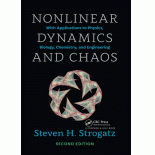
Nonlinear Dynamics and Chaos
2nd Edition
ISBN: 9780429972195
Author: Steven H. Strogatz
Publisher: Taylor & Francis
expand_more
expand_more
format_list_bulleted
Question
Chapter 6.5, Problem 8E
Interpretation Introduction
Interpretation:
Write out Hamiltonian equations for the simple harmonic oscillator of mass
Concept Introduction:
Hamiltonian equations of motions are
Total energy E of the harmonic oscillator can be expressed as
The potential energy of harmonic oscillator is
Expert Solution & Answer
Want to see the full answer?
Check out a sample textbook solution
Students have asked these similar questions
Pls help asap
Pls help asap
Pls help asap
Chapter 6 Solutions
Nonlinear Dynamics and Chaos
Ch. 6.1 - Prob. 1ECh. 6.1 - Prob. 2ECh. 6.1 - Prob. 3ECh. 6.1 - Prob. 4ECh. 6.1 - Prob. 5ECh. 6.1 - Prob. 6ECh. 6.1 - Prob. 7ECh. 6.1 - Prob. 8ECh. 6.1 - Prob. 9ECh. 6.1 - Prob. 10E
Ch. 6.1 - Prob. 11ECh. 6.1 - Prob. 12ECh. 6.1 - Prob. 13ECh. 6.1 - Prob. 14ECh. 6.2 - Prob. 1ECh. 6.2 - Prob. 2ECh. 6.3 - Prob. 1ECh. 6.3 - Prob. 2ECh. 6.3 - Prob. 3ECh. 6.3 - Prob. 4ECh. 6.3 - Prob. 5ECh. 6.3 - Prob. 6ECh. 6.3 - Prob. 7ECh. 6.3 - Prob. 8ECh. 6.3 - Prob. 9ECh. 6.3 - Prob. 10ECh. 6.3 - Prob. 11ECh. 6.3 - Prob. 12ECh. 6.3 - Prob. 13ECh. 6.3 - Prob. 14ECh. 6.3 - Prob. 15ECh. 6.3 - Prob. 16ECh. 6.3 - Prob. 17ECh. 6.4 - Prob. 1ECh. 6.4 - Prob. 2ECh. 6.4 - Prob. 3ECh. 6.4 - Prob. 4ECh. 6.4 - Prob. 5ECh. 6.4 - Prob. 6ECh. 6.4 - Prob. 7ECh. 6.4 - Prob. 8ECh. 6.4 - Prob. 9ECh. 6.4 - Prob. 10ECh. 6.4 - Prob. 11ECh. 6.5 - Prob. 1ECh. 6.5 - Prob. 2ECh. 6.5 - Prob. 3ECh. 6.5 - Prob. 4ECh. 6.5 - Prob. 5ECh. 6.5 - Prob. 6ECh. 6.5 - Prob. 7ECh. 6.5 - Prob. 8ECh. 6.5 - Prob. 9ECh. 6.5 - Prob. 10ECh. 6.5 - Prob. 11ECh. 6.5 - Prob. 12ECh. 6.5 - Prob. 13ECh. 6.5 - Prob. 14ECh. 6.5 - Prob. 15ECh. 6.5 - Prob. 16ECh. 6.5 - Prob. 17ECh. 6.5 - Prob. 18ECh. 6.5 - Prob. 19ECh. 6.5 - Prob. 20ECh. 6.6 - Prob. 1ECh. 6.6 - Prob. 2ECh. 6.6 - Prob. 3ECh. 6.6 - Prob. 4ECh. 6.6 - Prob. 5ECh. 6.6 - Prob. 6ECh. 6.6 - Prob. 7ECh. 6.6 - Prob. 8ECh. 6.6 - Prob. 9ECh. 6.6 - Prob. 10ECh. 6.6 - Prob. 11ECh. 6.7 - Prob. 1ECh. 6.7 - Prob. 2ECh. 6.7 - Prob. 3ECh. 6.7 - Prob. 4ECh. 6.7 - Prob. 5ECh. 6.8 - Prob. 1ECh. 6.8 - Prob. 2ECh. 6.8 - Prob. 3ECh. 6.8 - Prob. 4ECh. 6.8 - Prob. 5ECh. 6.8 - Prob. 6ECh. 6.8 - Prob. 7ECh. 6.8 - Prob. 8ECh. 6.8 - Prob. 9ECh. 6.8 - Prob. 10ECh. 6.8 - Prob. 11ECh. 6.8 - Prob. 12ECh. 6.8 - Prob. 13ECh. 6.8 - Prob. 14E
Knowledge Booster
Learn more about
Need a deep-dive on the concept behind this application? Look no further. Learn more about this topic, advanced-math and related others by exploring similar questions and additional content below.Similar questions
- | Without evaluating the Legendre symbols, prove the following. (i) 1(173)+2(2|73)+3(3|73) +...+72(72|73) = 0. (Hint: As r runs through the numbers 1,2,. (ii) 1²(1|71)+2²(2|71) +3²(3|71) +...+70² (70|71) = 71{1(1|71) + 2(2|71) ++70(70|71)}. 72, so does 73 – r.)arrow_forwardBy considering the number N = 16p²/p... p² - 2, where P1, P2, … … … ‚ Pn are primes, prove that there are infinitely many primes of the form 8k - 1.arrow_forward(c) (i) By first considering the case where n is a prime power, prove that n μ² (d) = ø(n) (d)' n≥ 1. d\n (ii) Verify the result of part (c)(i) when n = 20.arrow_forward
- 8arrow_forwardQ1.4 1 Point V=C(R), the vector space of all real-valued continuous functions whose domain is the set R of all real numbers, and H is the subset of C(R) consisting of all of the constant functions. (e.g. the function ƒ : R → R defined by the formula f(x) = 3 for all x E R is an example of one element of H.) OH is a subspace of V. H is not a subspace of V. Save Answerarrow_forwardExample 3.2. Solve the following boundary value problem by ADM (Adomian decomposition) method with the boundary conditions მი მი z- = 2x²+3 дг Əz w(x, 0) = x² - 3x, θω (x, 0) = i(2x+3). ayarrow_forward
arrow_back_ios
SEE MORE QUESTIONS
arrow_forward_ios
Recommended textbooks for you
 Linear Algebra: A Modern IntroductionAlgebraISBN:9781285463247Author:David PoolePublisher:Cengage Learning
Linear Algebra: A Modern IntroductionAlgebraISBN:9781285463247Author:David PoolePublisher:Cengage Learning

Linear Algebra: A Modern Introduction
Algebra
ISBN:9781285463247
Author:David Poole
Publisher:Cengage Learning
UG/ linear equation in linear algebra; Author: The Gate Academy;https://www.youtube.com/watch?v=aN5ezoOXX5A;License: Standard YouTube License, CC-BY
System of Linear Equations-I; Author: IIT Roorkee July 2018;https://www.youtube.com/watch?v=HOXWRNuH3BE;License: Standard YouTube License, CC-BY